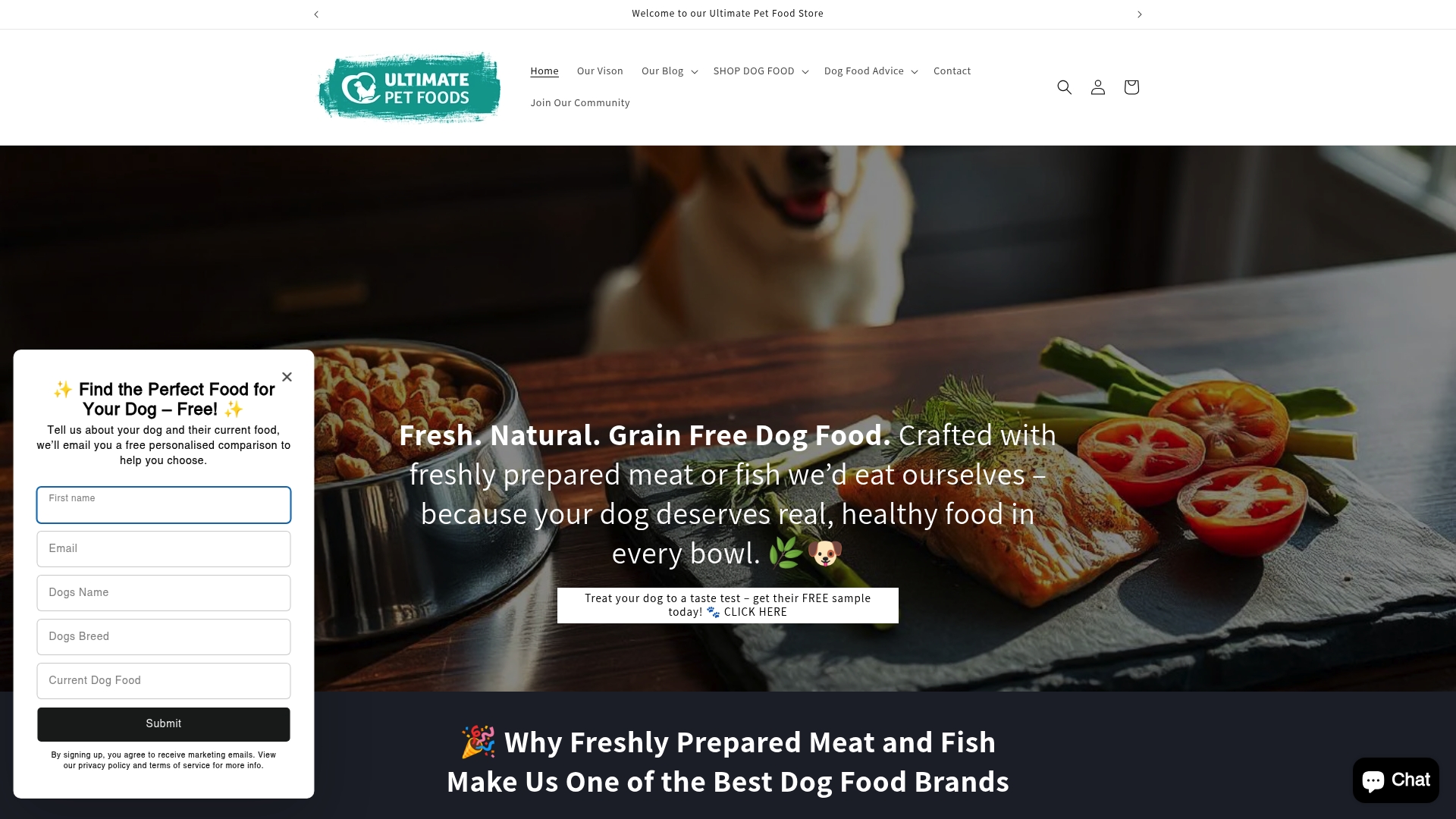
Can You Mix Dog Food Brands for Healthier Eating?
Share
Mixing dog food brands might seem like a simple way to keep your pup happy and healthy. But most people are surprised to learn that nearly 40 percent of dogs show food sensitivities when switching brands rapidly. The real surprise? A carefully planned blend of different dog foods can actually improve nutrition and reduce common health issues if you follow the right steps.
Table of Contents
- Step 1: Evaluate Your Dog’s Dietary Needs
- Step 2: Research Compatible Dog Food Brands
- Step 3: Gradually Introduce New Food Mixes
- Step 4: Monitor Your Dog’s Response
- Step 5: Adjust Ratios Based on Observations
Quick Summary
| Key Point | Explanation |
|---|---|
| 1. Evaluate Your Dog’s Nutritional Needs | Assess age, breed, weight, and health to determine your dog’s dietary requirements. |
| 2. Research Compatible Dog Food Brands | Look for brands with similar nutrients and avoid mixing conflicting ingredients. |
| 3. Gradually Introduce New Foods | Start with a small ratio of new food and slowly increase over 10-14 days. |
| 4. Monitor Your Dog’s Response | Track weight, stool quality, and energy levels to identify any issues. |
| 5. Adjust Feeding Ratios Based on Feedback | Modify food ratios according to your dog’s health indicators and tolerance. |
Step 1: Evaluate Your Dog’s Dietary Needs
Determining whether you can mix dog food brands starts with a comprehensive evaluation of your dog’s unique dietary requirements. This foundational step involves understanding your dog’s specific nutritional needs, which vary significantly based on multiple individual factors.
Understanding Individual Nutritional Profiles
Every dog represents a distinct nutritional landscape, influenced by age, breed, weight, activity level, and existing health conditions. Puppies, adult dogs, and senior canines have dramatically different caloric and nutrient requirements. Large breed dogs metabolize food differently compared to small breed companions, necessitating specialized nutritional approaches.
To begin this assessment, schedule a veterinary consultation to establish a baseline understanding of your dog’s health status. Your veterinarian can conduct comprehensive bloodwork, evaluate current weight, and identify any potential sensitivities or underlying health issues that might impact dietary choices. Weight, energy levels, coat condition, and digestive health serve as critical indicators of nutritional adequacy.
Identifying Potential Dietary Sensitivities
Some dogs experience food allergies or intolerances that complicate brand mixing. Common protein sources like chicken, beef, or wheat can trigger adverse reactions in sensitive dogs. Carefully observe your dog’s response when introducing new foods, watching for symptoms such as persistent itching, ear infections, gastrointestinal disturbances, or changes in stool consistency.
Before mixing brands, consider our guide on reading dog food ingredients to understand complex nutritional labels. Key verification criteria include:
- Consistent stool quality
- Maintained energy levels
- No visible skin or coat changes
- Normal appetite
Successful dietary evaluation requires patience, meticulous observation, and a willingness to adjust your approach based on your dog’s individual response. Remember that no universal formula exists every dog demands a personalized nutritional strategy.
Step 2: Research Compatible Dog Food Brands
Researching compatible dog food brands represents a critical step in successfully mixing nutritional sources for your canine companion. This process goes beyond simply selecting random brands and requires a strategic approach to ensuring nutritional compatibility and balanced dietary intake.
Analyzing Nutritional Composition
Successful dog food brand mixing demands a meticulous examination of nutritional profiles. Look for brands with similar protein sources, comparable macronutrient ratios, and complementary vitamin and mineral compositions. Not all dog foods are created equal, and variations in ingredient quality can significantly impact your dog’s health.
Start by comparing guaranteed analysis sections on dog food labels. Key factors to evaluate include protein percentage, fat content, fiber levels, and overall nutrient density. Premium brands typically provide more transparent nutritional information, allowing for more accurate comparison. Pay special attention to the primary protein sources, ensuring they align with your dog’s specific dietary needs and potential sensitivities.
Consulting Professional Resources
Before combining brands, consult multiple authoritative sources. Veterinary nutritionists and professional canine dietary experts can provide invaluable guidance on brand compatibility. Learn more about transitioning dog foods successfully to understand the nuanced process of introducing new nutritional sources.
Verification criteria for successful brand research include:
- Consistent ingredient quality across brands
- Comparable nutritional profiles
- Absence of conflicting supplement combinations
- Alignment with veterinary recommendations
Remember that brand mixing is not a one-size-fits-all solution. What works for one dog might not suit another. Continuous monitoring and willingness to adjust your approach remain crucial throughout this nutritional exploration. Approach this process as a gradual, carefully managed transition that prioritizes your dog’s individual health and well-being.
Step 3: Gradually Introduce New Food Mixes
Gradually introducing new food mixes is a delicate process that requires patience, careful observation, and a systematic approach. This step represents the critical transition phase where theoretical research transforms into practical nutritional strategy for your dog.
The Incremental Mixing Method
The key to successful dog food brand mixing lies in a slow and methodical integration. Begin by introducing new brands in minimal quantities, starting with a ratio of approximately 25% new food to 75% existing food. This conservative approach allows your dog’s digestive system to adapt without causing significant disruption or potential gastrointestinal stress.
Over a period of 10 to 14 days, progressively increase the proportion of new food while simultaneously decreasing the original brand. Carefully monitor your dog’s response during this transition, watching for subtle changes in energy levels, stool consistency, appetite, and overall well-being. Some dogs might require an even more extended adjustment period, particularly those with sensitive digestive systems or pre-existing health conditions.

Monitoring and Adaptation
Documenting your dog’s response becomes crucial during this phase. Keep a detailed log tracking food intake, portion sizes, and any observable changes. Our guide on transitioning dog foods successfully provides additional insights into managing this process effectively.
Key verification criteria for successful food mix introduction include:
- Consistent and normal stool quality
- Maintained energy levels
- No visible signs of digestive distress
- Sustained appetite
- Normal coat and skin condition
If your dog exhibits any negative reactions during the mixing process, such as vomiting, diarrhea, or significant changes in behavior, immediately revert to the original diet and consult your veterinarian.
Not all dogs will respond identically to food brand mixing, and individual variation is expected. Patience, close observation, and a willingness to adjust your approach are essential for successfully navigating this nutritional transition.
Step 4: Monitor Your Dog’s Response
Monitoring your dog’s response to new food brand mixing is a nuanced process that requires systematic observation and comprehensive tracking of multiple health indicators. This critical step transforms your nutritional experiment from theoretical strategy to practical implementation, ensuring your dog’s continued well-being and nutritional balance.
Comprehensive Health Tracking
Developing a detailed observation framework becomes essential during this phase. Begin by establishing baseline measurements before introducing new food brands. Document your dog’s current weight, body condition, energy levels, coat quality, and overall demeanor. These initial benchmarks will help you accurately assess any changes resulting from dietary modifications.
Create a comprehensive tracking log that captures daily observations. Record specific details such as meal times, portion sizes, food brand combinations, and your dog’s physical and behavioral responses. Pay close attention to subtle changes in digestion, including stool consistency, frequency of bowel movements, and any signs of gastrointestinal discomfort. Unusual changes in appetite, unexpected weight fluctuations, or shifts in energy levels could indicate potential nutritional incompatibility.
Recognizing Critical Warning Signs
Our expert guide on transitioning dog foods successfully provides additional insights into interpreting your dog’s nutritional responses. Critical warning signs that warrant immediate veterinary consultation include:
- Persistent diarrhea or constipation
- Significant weight loss
- Reduced appetite
- Excessive lethargy
- Skin irritations or unexpected allergic reactions
- Vomiting
Successful monitoring extends beyond immediate physical symptoms. Assess your dog’s long-term response by evaluating consistent indicators like muscle tone, coat shine, dental health, and overall vitality. Remember that each dog represents a unique nutritional ecosystem, and what works for one might not be ideal for another. Remain flexible, patient, and prepared to adjust your approach based on your dog’s individual needs and responses.
Below is a troubleshooting table to help identify and address common issues dogs may experience when mixing food brands, along with possible causes and recommended actions.
| Problem | Possible Cause | Recommended Action |
|---|---|---|
| Vomiting or diarrhea | Digestive upset from rapid food changes | Revert to original food, slow transition |
| Persistent itching | Food allergy to new ingredients | Stop new food, consult veterinarian |
| Reduced appetite | Dislike of new food or digestive distress | Adjust mix ratio, observe, consult vet |
| Lethargy | Nutritional incompatibility or stress | Monitor, consider slower transition |
| Unusual stool consistency | Sensitivity to new food or mix imbalance | Adjust ratios, track changes, vet consult |
| Weight loss | Insufficient calories/nutrient imbalance | Review food content, track weight, consult |
| Skin irritations | New ingredient allergy or intolerance | Remove new food, consult veterinarian |

Step 5: Adjust Ratios Based on Observations
Adjusting food brand ratios represents the most dynamic and personalized phase of your dog’s nutritional journey. This step transforms your initial research and monitoring into a precise, tailored feeding strategy that responds directly to your dog’s unique physiological needs and responses.
Interpreting Nutritional Signals
Careful and calculated adjustments are crucial when modifying food brand mixtures. Begin by reviewing your comprehensive tracking log, paying close attention to subtle changes in your dog’s overall health, energy levels, and digestive performance. If your initial 25/75 food ratio produced mild digestive irregularities, consider slowing the transition by reducing the new food percentage or extending the adjustment timeline.
Some dogs might require more gradual transitions, while others adapt quickly. Watch for specific indicators that suggest either increasing or decreasing the proportion of mixed brands. Positive signs include consistent stool quality, maintained energy levels, stable weight, and a glossy coat. Conversely, persistent digestive issues, unexpected weight changes, or reduced vitality signal the need for immediate ratio recalibration.
Strategic Ratio Modification
Our expert guide on transitioning dog foods successfully provides additional insights into nuanced food ratio adjustments. When modifying mixtures, implement changes incrementally, typically in 5-10% increments. This measured approach allows your dog’s digestive system to adapt without experiencing significant nutritional shock.
Key considerations for successful ratio adjustment include:
- Maintaining consistent portion sizes
- Tracking weight and body condition
- Observing energy and activity levels
- Monitoring digestive health
- Consulting veterinary professionals for personalized guidance
Remember that food brand mixing is not a one-time event but an ongoing process of observation, adaptation, and refinement. Some dogs might require multiple adjustment cycles to achieve optimal nutritional balance. Remain patient, attentive, and prepared to pivot your strategy based on your dog’s individual response. Your commitment to careful monitoring and willingness to make informed adjustments will ultimately support your dog’s long-term health and well-being.
Discover Healthier Dog Food Mixing with Ultimate Pet Foods
Trying to mix dog food brands but worried about your dog’s nutrition and digestive health? At Ultimate Pet Foods, we understand the challenge of finding safe, high-quality blends that support each stage of your pet’s life. Whether you own a playful puppy or a small breed with special needs, our selection of premium, grain-free dog foods gives you complete control over your mixing strategy. Choose from carefully crafted options like our Grain free small breed dog food to tackle issues such as food sensitivities, inconsistent stool, or changing energy levels.

Give your dog the balanced nutrition they deserve. Visit https://ultimatepetfoods.co.uk to explore the healthiest choices for tailored feeding plans. Select from specialized formulas, find ingredient transparency, and experience the peace of mind that comes with wholesome, science-backed nutrition. Mix with confidence today and help your best friend thrive.
Frequently Asked Questions
Can I mix different dog food brands?
Yes, you can mix different dog food brands, but it’s essential to evaluate your dog’s individual dietary needs and choose compatible brands with similar nutritional profiles.
How do I know if my dog has dietary sensitivities?
Observe your dog for signs of food allergies or intolerances, such as itching, gastrointestinal disturbances, or changes in stool. A vet consultation can help identify specific sensitivities.
What’s the best way to introduce a new dog food mix?
Start with a gradual introduction by mixing approximately 25% of the new food with 75% of the original food, then slowly adjust the ratios over 10 to 14 days while monitoring your dog’s response.
What should I monitor when mixing dog food brands?
Track your dog’s weight, energy levels, coat condition, stool consistency, and any signs of digestive distress to ensure the new food mix is suitable for their health.
